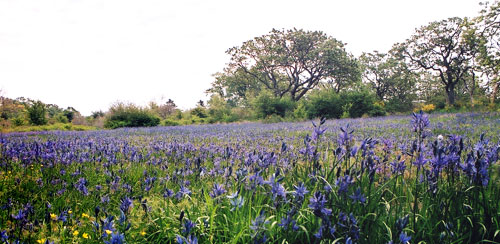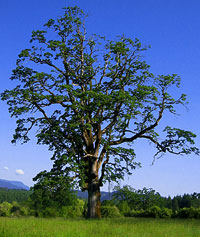About Garry Oak Ecosystems
A Garry oak ecosystem has naturally occurring Garry oak trees (Quercus garryana) and some semblance of the ecological processes and communities that prevailed before European settlement.

Garry oak meadow with camas lilies, Uplands Park (photo by Chris Junck)
Garry oaks (Quercus garryana) are the only native oak trees in western Canada (west of Manitoba). They are named after Nicholas Garry who was the deputy governor of the Hudson’s Bay Company from 1822–1835. South of the border, these trees are often referred to as Oregon white oaks. With their striking, gnarly shape and unique adaptations to the Mediterranean-like climate of the rain shadow of the Vancouver Island, Coastal, and Olympic mountains, they have become a symbol of their ecosystems.
“An ecosystem consists of a dynamic set of living organisms (plants, animals and microorganisms) all interacting among themselves and with the environment in which they live (soil, climate, water and light).” —Canadian Forest Service, Natural Resources Canada
While individual oaks are majestic, and their retention adds to the beauty and habitat potential of developed areas, intact Garry oak ecosystems are a rich mosaic of plant, animal and insect species.
Garry oak ecosystems range from shady woodlands to open meadows with scattered trees. Garry oak trees can be found amongst other trees, mainly arbutus and Douglas-fir. Under the shelter of oak canopies or in meadows, spring wildflowers, grasses, mosses, and a variety of shrubs flourish. Garry oak ecosystems also support many lichens and fungi, and are home to a variety of animals which thrive in these unique environments. For more details, see the Literature Review.

photo by Tim Ennis – Nature Conservancy of Canada
Garry oak ecosystems may often be found near, or in combination with, other ecosystems that do not contain Garry oak trees. These associated sites often share many characteristics with Garry oak ecosystems, including the types of disturbance experienced or expected to occur, like wildfires or grazing by wildlife. Some of the species found in associated ecosystems are also common to Garry oak ecosystems, while some may be restricted to particular habitat types.
Associated ecosystems are highly varied and include rock outcrops and coastal bluffs, maritime meadows and treeless grasslands, along with seasonal wetlands and small pools which disappear during droughts. Also included are transitional forests that have an oak component.
These associated ecosystems share not only biological and ecological characteristics with Garry oak ecosystems, but are also vulnerable to many of the same threats to long-term survival. For this reason, we include associated ecosystems when considering management, restoration and protection of Garry oak ecosystems.
